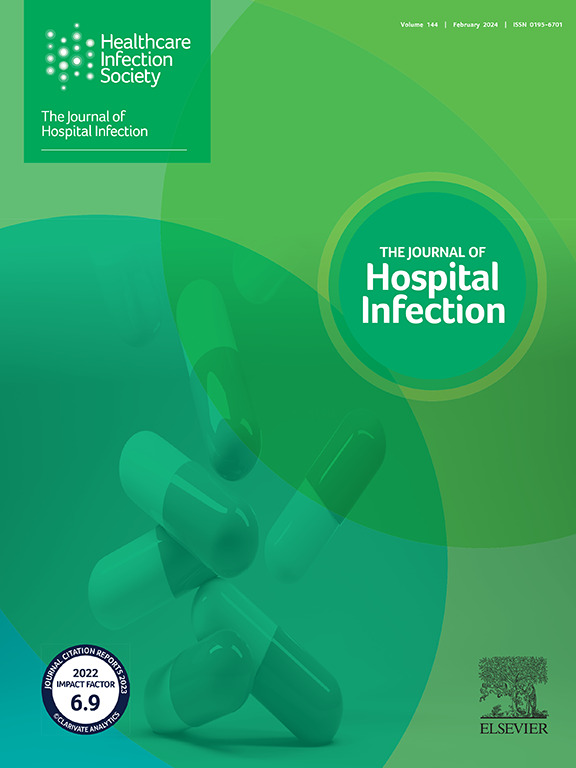耐碳青霉烯的Providencia spp:门口的威胁。
IF 3.1
3区 医学
Q1 INFECTIOUS DISEASES
引用次数: 0
摘要
背景:普罗维登菌属是与医院感染相关的新出现的机会致病菌,特别是在免疫功能低下患者和住院时间较长的患者中。由于有限的治疗选择,耐碳青霉烯的普罗维登斯氏菌的流行率日益增加,对治疗提出了重大挑战。目的:本研究旨在评估碳青霉烯耐药和碳青霉烯敏感的普罗维登斯感染患者的临床特征、危险因素和结局。方法:对2020年1月1日至2024年1月1日住院的普罗维登西亚分离株患者进行回顾性观察性研究。根据碳青霉烯敏感性对患者进行分层。比较碳青霉烯耐药病例和碳青霉烯敏感病例的临床资料、危险因素和死亡率。统计分析确定碳青霉烯耐药的独立危险因素。结果:118例普罗维登斯菌相关感染中,53例(44.9%)为碳青霉烯类耐药。优势种为雷氏普罗维登菌(67.8%),其碳青霉烯烯耐药率显著高于施塔蒿(p=0.003)。碳青霉烯耐药感染以尿路感染最为常见(58.5%),而碳青霉烯敏感感染以皮肤和软组织感染最为常见(40.0%)(结论:碳青霉烯耐药普罗维登斯感染与发病率和死亡率增高相关)。鉴于治疗选择有限,应加强感染控制措施和抗菌药物管理规划。需要进一步的大规模研究来确定耐药机制和最佳治疗策略。本文章由计算机程序翻译,如有差异,请以英文原文为准。
Carbapenem-resistant Providencia spp.: the threat at the door
Background
Providencia species are emerging opportunistic pathogens associated with nosocomial infections, particularly in immunocompromised patients and those with prolonged hospital stays. The increasing prevalence of carbapenem-resistant Providencia spp. poses a significant therapeutic challenge due to limited treatment options.
Aim
To evaluate the clinical characteristics, risk factors, and outcomes of patients with carbapenem-resistant and carbapenem-susceptible Providencia spp. infections.
Methods
A retrospective, observational study was conducted, including hospitalized patients with Providencia spp. isolates between January 1st, 2020 and January 1st, 2024. Patients were stratified based on carbapenem susceptibility. Clinical data, risk factors, and mortality rates were compared between carbapenem-resistant and carbapenem-susceptible cases. Statistical analyses were performed to identify independent risk factors for carbapenem resistance.
Findings
Among 118 Providencia-associated infections, 53 (44.9%) were carbapenem-resistant. Providencia rettgeri was the predominant species (67.8%), with a significantly higher carbapenem resistance rate than P. stuartii (P = 0.003). Carbapenem-resistant infections were most commonly urinary tract infections (58.5%), while carbapenem-susceptible infections were more frequently associated with skin and soft tissue infections (40.0%) (P < 0.001). Carbapenem-resistant cases exhibited longer hospital stays, increased ICU admissions, and higher mortality rates (P < 0.05). Risk factors for carbapenem resistance included prior ICU admission, mechanical ventilation, urinary catheterization, and prior carbapenem use.
Conclusion
Carbapenem-resistant Providencia infections are associated with increased morbidity and mortality. Given the limited therapeutic options, infection control measures and antimicrobial stewardship programmes should be strengthened. Further large-scale studies are needed to characterize resistance mechanisms and optimal treatment strategies.
求助全文
通过发布文献求助,成功后即可免费获取论文全文。
去求助
来源期刊

Journal of Hospital Infection
医学-传染病学
CiteScore
12.70
自引率
5.80%
发文量
271
审稿时长
19 days
期刊介绍:
The Journal of Hospital Infection is the editorially independent scientific publication of the Healthcare Infection Society. The aim of the Journal is to publish high quality research and information relating to infection prevention and control that is relevant to an international audience.
The Journal welcomes submissions that relate to all aspects of infection prevention and control in healthcare settings. This includes submissions that:
provide new insight into the epidemiology, surveillance, or prevention and control of healthcare-associated infections and antimicrobial resistance in healthcare settings;
provide new insight into cleaning, disinfection and decontamination;
provide new insight into the design of healthcare premises;
describe novel aspects of outbreaks of infection;
throw light on techniques for effective antimicrobial stewardship;
describe novel techniques (laboratory-based or point of care) for the detection of infection or antimicrobial resistance in the healthcare setting, particularly if these can be used to facilitate infection prevention and control;
improve understanding of the motivations of safe healthcare behaviour, or describe techniques for achieving behavioural and cultural change;
improve understanding of the use of IT systems in infection surveillance and prevention and control.
 求助内容:
求助内容: 应助结果提醒方式:
应助结果提醒方式:


